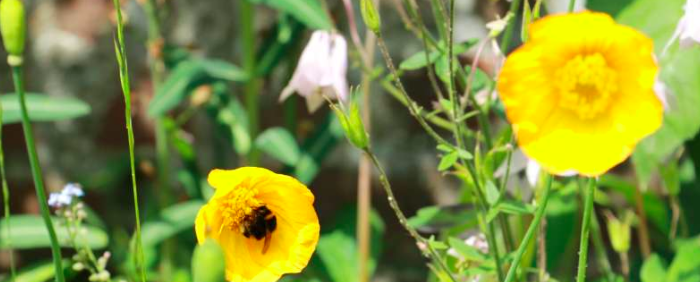
Audrey’s little vegetable garden, a very motivated beginner gardener, and a mother of two young children – so exhausted overall, except in the garden!
If I still know the words of Maya the Bee is good thanks to the biodiversity!
It will be necessary to apply a little if we want our children to eat honey all their lives.
In short, as would say “hummingbirds”, “I do my part”, and I decided to do everything possible so that the bees and their crawling and flying friends live in my little garden all year round.
The goal of biodiversity
Attract a maximum of different species flowers as much as fauna because the higher the biodiversity, the more stable and resistant the system will be.
The risks of massive attacks of pests will thus be less.
A little trick in passing against the slugs: I left an old wooden board next to my kitchen squares and I noticed by raising it that it sheltered a nice family of slugs, so I left it there, it prevents them from attacking the lettuce, it seems to work pretty well …
How to do it ?
Zero chemistry : no pesticides or insecticides but natural fertilizers that will help maintain this eco-system in good health.
Compost, manure, nettle manure, lupine, alfalfa, organic fertilizer made from seaweed powder and other pee.
As prevention is generally better than cure, these natural fertilizers will be precious!
Every season his task.
In the spring we sow the honey plants, they will produce the nectar for it to booty max in your garden.
I already had a lot of small wild flowers in my garden: clover, dandelions, poppies for pollen, besides this one Thibaut what is it?
– Thibaut: “It is a rhizomatous geranium, a very good companion to the wild garden. It flowers for a very long time and can cover the ground between shrubs and large perennials »
I added to that borage, lavender, thyme, sage, raspberry, wild garlic, and mulberry trees.
In summer always think well of mulching the soil that should never dry, the plants will be the best and insects too. It is also a good time to feed the plants (tomatoes, cabbage, celery with vegetable purines that will also activate the living organisms in the soil.)
Do not be too angry against aphids because they will attract ladybugs.
And tidy eggs on a nasturtium leaf may become cute butterflies.
Little summer recipe in passing:
Omelette chives parsley and flowery salad.
Nasturtiums can also be replaced by borage flowers, I have blue and white is very chic too.
In autumn the dead leaves are precious, they will maintain a blanket on the ground for small animals.
And in winter we build hotel insects so that everyone can rest easy and we continue to take care of the compost.
Personally, this winter I threw directly my peelings on the earth of the vegetable squares and I covered with straw, it makes go up the small worms which come to eat on the surface and which continue to aerate the earth. (Note by Thibaut: yes, it is the “surface compost”, we did an article to extol the merits.) Adding straw also prevents the earth from being frozen during periods of extreme cold.
It is also in winter that I plan my future plantings, and that I sort my little grandma seeds. It’s the good season to pick up my little notebooks and imagine what will grow in my future squares. By focusing on polyculture, the land and its inhabitants are helped to regenerate.
All this to contemplate one day a pretty little blue butterfly that will be eaten by my cat – or not.